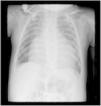We report the case of a four-month-old infant with Down's syndrome referred for observation due to progressive tachypnea and failure to thrive. Chest radiography revealed cardiomegaly and pulmonary congestion (Figure 1). Transthoracic echocardiography showed severely dilated left-sided chambers with global systolic dysfunction, but was inconclusive regarding the underlying abnormality due to the patient's poor acoustic window (Figure 2). On cardiac catheterization, the child was found to have a 10 mm long, 3.8 mm wide patent ductus arteriosus, anatomically unsuitable for percutaneous closure, and a hypoplastic left coronary artery (Figure 3). The patient underwent an uneventful surgical ligation of the ductus via lateral thoracotomy and was discharged after six days. One month later, the child was admitted to the pediatric ICU with respiratory failure requiring mechanical ventilation. Transthoracic echocardiography revealed a severely dilated left ventricle with dyskinesia of the posterior and lateral walls. Due to lack of clinical improvement, a cardiac computed tomography was performed, revealing a large type I aortopulmonary window (10 mm×10 mm) between the right aspect of the distal pulmonary trunk and the left aspect of the ascending aorta (Figure 4). After surgical closure with an aortic cuff, the patient presented gradual clinical recovery until discharge with residual systolic dysfunction and tachypnea. Through careful analysis, the aortopulmonary window was found to be already visible on the catheterization cines, but was probably overlooked due to the concomitant ductus. The authors wish to highlight that, even in the presence of a common congenital heart defect, additional abnormalities must always be carefully excluded.
Cardiac catheterization: (A) anteroposterior view: aortography revealed normal origin of the coronary arteries with a hypoplastic left coronary artery (arrow), and clear presence of an extracardiac left-to-right shunt, which was later found to be mostly due to the presence of an aortopulmonary window (*); (B) lateral view: selective aortic angiography showed the presence of a patent ductus arteriosus (arrow), which was deemed unsuitable for percutaneous closure.
The authors have no conflicts of interest to declare.












